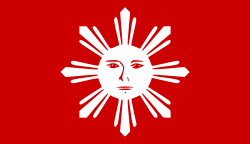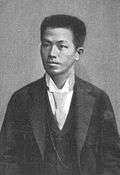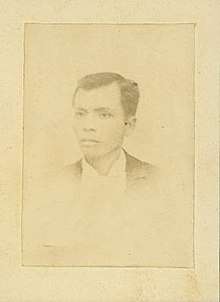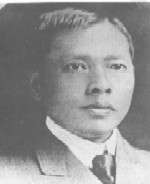Tejeros Convention
The Tejeros Convention (alternate names include Tejeros Assembly and Tejeros Congress) was the meeting held on March 22, 1897 between the Magdiwang and Magdalo factions of the Katipunan at San Francisco de Malabon (now General Trias,[1][3] but the site is now at Rosario), Cavite. These are the first presidential and vice presidential elections in Philippine history, although only the Katipuneros (members of the Katipunan) were able to take part, and not the general populace.
| |||||||||||||||||||||
| |||||||||||||||||||||
| |||||||||||||||||||||

Convention
Purpose
The convention was called to discuss the defense of Cavite against the Spaniards during the Philippine Revolution. The contemporary Governor General, Camilo de Polavieja, had regained much of Cavite itself. Instead, the convention became an election to decide the leaders of the revolutionary movement, bypassing the Supreme Council.
The revolutionary leaders held an important meeting in a friar estate residence in Tejeros to resume their discussions regarding the escalating tension between the Magdalo and Magdiwang forces; And also to settle once and for all the issue of governance within the Katipunan through an election.[4] Amidst implications on whether the Katipunan, which operated as an alternative revolutionary government,[5] should be established as a monarchy or as a republic, Bonifacio defended that it should be maintained as a republic. According to him, all of its members of any given rank shall serve under the principle of liberty, equality and fraternity, upon which republicanism was founded.[6] Despite Bonifacio's concern on the lack of officials and representatives from other provinces, The Magdalo was obliged to proceed with the election.[7]
Election results
| Tejeros Revolutionary Government | |
|---|---|
| Pamahalaang Panghimagsikan ng Tejeros | |
 Flag | |
| Overview | |
| Established | March 22, 1897 |
| Dissolved | November 1, 1897 |
| State | Philippines |
| Leader | President |
| Main organ | Cabinet |
| Headquarters | San Francisco de Malabon, Cavite |
Andrés Bonifacio, the contemporary Supremo (supreme leader) of the Katipunan, presided over the election. He secured the unanimous approval that the decision would not be questioned.
| Candidate | Faction | Results | |
|---|---|---|---|
| Votes | % | ||
| Emilio Aguinaldo | Magdalo | 146 | 57.03% |
| Andrés Bonifacio | Magdiwang | 80 | 31.25% |
| Mariano Trías | Magdiwang | 30 | 11.72% |
| Valid votes | 256 | 100.00% | |
| Votes cast | 256 | 100.00% | |
| Registered voters | 256 | 100.00% | |
The results of the election:
| Position | Name | Faction |
|---|---|---|
| President | Emilio Aguinaldo | Magdalo |
| Vice-President | Mariano Trías | Magdiwang |
| Captain-General | Artemio Ricarte | Magdiwang |
| Director of War | Emiliano Riego de Dios | Magdiwang |
| Director of the Interior | Andrés Bonifacio | Magdiwang |
Bonifacio accepted the decision, but not before insisting on a recount of the votes. Supporters such as Severino de las Alas made abortive efforts to help make Bonifacio vice president.[8] However, Daniel Tirona objected that the post should not be occupied by a person without a lawyer's diploma. He suggested a lawyer like Jose del Rosario is qualified for the suitable position.[9] Bonifacio was insulted, and demanded that Tirona retract the remark. When Tirona made to leave instead, Bonifacio drew a pistol and was about to fire at Tirona, but stopped when Ricarte tried to disarm him.[9] Bonifacio then voided the convention as Supremo of the Katipunan.[10]
Some Magdiwang leaders, led by Pio del Pilar and Mariano Llanera, recanted their previous insistence that the result of the convention is null and void, thereby recognizing the validity of the elected leaders, and later occupying the five vacant positions upon appointment from Aguinaldo. The newly appointed officials took their oath of office on April 24, 1897. Aguinaldo, on the same day, convened the first session of the cabinet and issued an official circular informing the town presidents of all municipalities that he was duly elected by the convention and was assuming his position as president.[11]
| Position | Name | Term | Political Faction |
|---|---|---|---|
| President | Emilio Aguinaldo | March 23, 1897 - November 1, 1897 | Magdalo |
| Vice-President | Mariano Trías | March 23, 1897 - November 1, 1897 | Magdiwang |
| Captain-General | Artemio Ricarte | March 23, 1897 - November 1, 1897 | Magdiwang |
| Director of War | Emiliano Riego de Dios | April 24, 1897 - November 1, 1897 | Magdiwang |
| Director of State | Jacinto Lumbreras | April 24, 1897 - November 1, 1897 | Magdiwang |
| Director of Finance | Baldomero Aguinaldo | March 23, 1897 - November 1, 1897 | Magdalo |
| Director of Welfare | Mariano Alvarez | April 24, 1897 - November 1, 1897 | Magdiwang |
| Director of Justice | Severino de las Alas | April 24, 1897 - November 1, 1897 | Magdiwang |
| Director of the Interior | Pascual Alvarez | April 24, 1897 - November 1, 1897 | Magdiwang |
Allegations of fraud
In addition to Bonifacio's statement voiding the outcome the probity of the election held has been questioned, with allegations that many ballots distributed were already filled out and that the voters had not done this themselves.[12]
In their memoirs, Santiago Álvarez and Gregoria de Jesús both alleged that many ballots were already filled out before being distributed, and Guillermo Masangkay contended there were more ballots prepared than voters present. Álvarez writes that Bonifacio had been warned by a Cavite leader Diego Mojica of the rigged ballots before the votes were canvassed, but he had done nothing.[6][13]
Post-convention events
Aguinaldo
Emilio Aguinaldo was not present at the convention, but was at a military front at Pasong Santol, a barrio of Dasmariñas, Cavite. He was notified of his election to the Presidency the following day, and his elder brother, Crispulo Aguinaldo, persuaded him to travel to take the oath of office. Leaving Crispulo in command, Aguinaldo traveled to Santa Cruz de Malabon (now Tanza, Cavite), where he and the others elected, with the exception of Bonifacio, took their oath of office. Crispulo Aguinaldo was among those killed in the Battle of Pasong Santol between March 7 and 24, 1897, which ended with a Spanish victory.[10] Aguinaldo surreptitiously took his oath of office as President in a chapel officiated by a Catholic priest Cenon Villafranca who was under the authority of the Roman pope.[14]:109 According to Gen. Santiago Alvarez, guards were posted outside with strict instructions not to let in any unwanted partisan from the Magdiwang faction while the oath-taking took place.[15] Artemio Ricarte also took his office "with great reluctance" and made a declaration that he found the Tejeros elections "dirty or shady" and "not been in conformity with the true will of the people."[16] After assuming the Presidency, Aguinaldo sent a delegation to contact Bonifacio and persuade him to cooperate with the newly constituted government. The delegation was able to contact Bonifacio, but was unable to persuade him to cooperate.[17]
Bonifacio
| Wikisource has original text related to this article: |
| Wikisource has original text related to this article: |
After leaving the convention, Bonifacio met on March 28 with 45 of his followers. Convinced that the election at the convention had been invalid, they drew up a document titled Acta de Tejeros giving their reasons for having rejected the convention results.[3] They then proceeded to Naik and drew up another document, sometimes referred to as the Naic Military Agreement, repudiating the insurgent government established at Tejeros.[18] Several complaints against Bonifacio, notably from Severino de las Alas and Jose Coronel, were presented to Emilio Aguinaldo. Aguinaldo dispatched a force to Naik, which arrested Andres and Procopio Bonifacio after an exchange of gunfire in which Andres was wounded and his older brother, Ciriaco, was killed. Andres and Procopio were tried on charges of treason by members of the war council of Aguinaldo's government. On May 10, 1897, the brothers were executed.[19][20]
References
- "Andres Bonifacio and the Katipunan". nhcp.gov.ph. National Historical Commission of the Philippines. September 4, 2012. Retrieved February 28, 2020.
- Zaide, Gregorio F. (1968). The Philippine Revolution. Modern Book Company. p. 123.
- "Tejeros Convention". Presidential Museum and Library, Malacañan Palace.
- Constantino 1975, p. 184
- "Katipunan". Retrieved December 10, 2019.
It operated as an alternative Filipino government complete with a president and cabinet.
- Alvarez 1992.
- Constantino 1975, pp. 185–186
- Alvarez 1992, p. 107.
- Alvarez 1992, p. 108.
- Agoncillo 1990, p. 178.
- "Andres Bonifacio and others, Declaration, c. April 19, 1897 (The "Naik Military Agreement") - Katipunan: Documents and Studies". www.kasaysayan-kkk.info.
- Ambeth Ocampo, Election fraud at the Tejeros Convention Archived 2010-06-30 at the Wayback Machine (November 5, 2007), Philippine Daily Inquirer.
- Guerrero 1998, p. 192.
- Alvarez, S.V., 1992, Recalling the Revolution, Madison: Center for Southeast Asia Studies, University of Wisconsin-Madison, ISBN 1-881261-05-0
- Álvarez 1992.
- Artemio Ricarte Declaration dated March 24, 1897. "Archived copy". Archived from the original on August 19, 2011. Retrieved May 22, 2011.CS1 maint: archived copy as title (link)
- Agoncillo 1990, pp. 178-179.
- "Andres Bonifacio and others, Declaration, c. April 19, 1897 (The "Naik Military Agreement")". Katipunan: Documents and Studies. December 11, 2018.
- "Artemio Ricarte on the Arrest and Execution of Bonifacio - Presidential Museum and Library".
- Agoncillo 1990, pp. 179-181.
Bibliography
| Wikimedia Commons has media related to Tejeros Convention. |
- The Tejeros Assembly of 1897 MSC Computer Training Center
- Katipunan and the Acto de Tejeros, March 23, 1897, Documents of the Katipunan, Katipunan : Documents and studies
- Agoncillo, Teodoro C. (1990) [1960]. History of the Filipino People (8th ed.). Quezon City: Garotech Publishing. ISBN 971-8711-06-6.CS1 maint: ref=harv (link)
- Alvarez, Santiago V. (1992). Recalling the revolution: memoirs of a Filipino general. University of Wisconsin, Center for Southeast Asian Studies. ISBN 978-1-881261-05-6.CS1 maint: ref=harv (link)
- Constantino, Renato (1975). The Philippines: A Past Revisited. Quezon City: Tala Publishing Services. ISBN 971-8958-00-2.CS1 maint: ref=harv (link)
- Guerrero, Milagros; Schumacher, S.J., John (1998). Reform and Revolution. Kasaysayan: The History of the Filipino People. 5. Asia Publishing Company Limited. ISBN 962-258-228-1.


